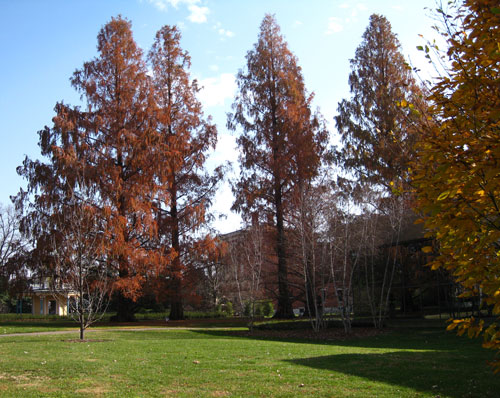Dawn Redwood – A Favorite Tree
Contact
University of Arkansas System Division of Agriculture
Cooperative Extension Service
2301 S. University Ave.
Little Rock, AR 72204

Dawn Redwood – A Favorite Tree

The dawn redwood is one of my favorite trees because it has such an interesting backstory – one that is becoming more important in this changing world.
I’m a sucker for a compelling story, so it should not be surprising that my favorite trees are those with interesting and involved backstories. One of these favorites – dawn redwood (Metasequoia glyptostroboides) – I met in a 30-million-year-old fossil bed in Oregon a few weeks ago. How is it that this so called “living fossil” grew in what is now a barren wasteland of eroded badlands?
Most plant people know the story of the dawn redwood, but it is such a good story that repeating it can’t hurt. In the war years of the early 1940s, Chinese botanists happened upon a tree growing beside a rice paddy in central China’s Hubei Province, which the locals called “water fir.” Unsure of what it was, the botanists’ herbarium samples ended up at the Arnold Arboretum in 1946, where the tree was confirmed to be a new species.
Working with different Chinese collaborators, Elmer Merrill, director of Harvard’s Arnold Arboretum, and Ralph Chaney, from the University of California at Berkley, both dispatched funds to their respective collectors for seed and specimen collections in 1947 and 1948. The rush to take credit for this marvelous discovery – even though it was the Chinese teams who made the discovery and did the leg work – lead to one of the scientific food fights academia is famous for. Both men claimed to be the first to introduce this new plant find and make seeds available for collectors and scientific institutions across the world. By 1950, Metasequoia seedlings were growing throughout the northern hemisphere, both in the United States and in Europe.
Chaney in California had a better press team and came up with the name “dawn redwood” and the concept of referring to this fast-growing deciduous conifer as a “living fossil.” As it turns out, the scientific naming rights for the genus go to Japanese paleobotanist Shigeru Miki who, in 1941, published a paper describing some 5-million-year-old fossil leaves he found in Japan that matched misidentified fossil leaves – some dating from the 1880s in Montana, others from Europe – that had been erroneously identified as either the evergreen Coastal Redwoods and/or the deciduous bald cypress of our southeastern states. Correcting the error, Miki created the name Metasequoia – meaning similar to Sequoia, the giant redwood – while Wan-Chun Cheng (1904-1983) and Hsen Hsu Hu (1894-1968) of China described and named the living species. Hu knew of Miki’s work with the fossils and made the correlation between the fossil record and the living trees.
It is now apparent that dinosaurs probably never munched on dawn redwood leaves. The timeline doesn’t match. Fossils of Metasequoia are found across much of northern North America, Europe, Asia and in Greenland, but the oldest fossils I’m aware of date to about 50 million years ago in the far-north Ellesmere Island of Canada, which is inside the Arctic Circle. The dinosaurs went extinct about 65 million years ago. The fossils in the John Day Formation of central Oregon date to about 30 million years ago when the area was moist swampland.
While closely related to giant redwood, dawn redwoods aren’t nearly as large. But they can grow up to 200 feet tall in a moist, temperate climate. On Ellesmere Island, over two dozen standing trunks have been found, some with a diameter of over six feet. The deciduous nature of the species is thought to be an adaptation for growing in the far north when the poles were ice free. Deciduous trees could survive four months of darkness better than evergreens.
From a climate science standpoint, the distribution of dawn redwoods during this earlier epoch of earth’s history are important because they show how our planet is continually undergoing rapid and wild changes in the environment. The positions of the continents 50 million years ago were pretty much the same as they are today, but much of the land mass was under water because there was no ice at the poles. That means that Ellesmere Island and Greenland had a moist, temperate climate where dawn redwoods could grow, even though there was still a four-month long sun-less winter.
Scientists are looking at organic residues found in the Arctic from not-completely-fossilized dawn redwood specimens and comparing them to samples collected from the seeds that were distributed around the world 75 years ago. They are attempting to match current environmental parameters with what might have once existed in the far north 50 million years ago. As I said, a good backstory is important.